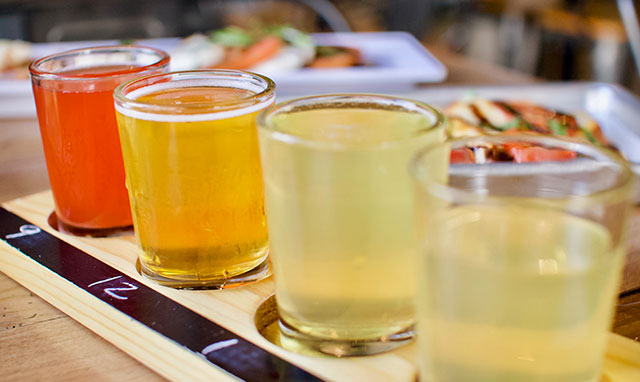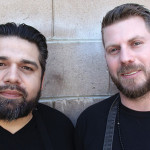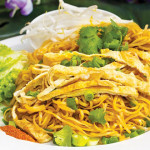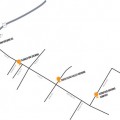Like so many who venture overseas, Claudia Derp was forever changed by her trek through Europe. Five years ago, before she boarded her flight, Derp had been in talks with a friend about starting a wine bar. By the time she returned, Derp had a different plan.
Her thinking began to evolve one evening in the United Kingdom when she happened to take a seat in a cider bar. “What is this?” Derp recalls thinking as she raised the fruity, bubbly and refreshing alcoholic beverage to her lips. And then: “This is awesome!”
As she continued her tour, she made a point of sampling more. When she got back to the states, Derp went straight to her wine friend, Tracy Smith, with the news. They ultimately changed course, turning from wine to cider.
It was a natural pivot for Smith, who has more than a decade of experience in winemaking. Though it is often lumped in with beer on restaurant menus, cider has more in common cabernet than IPA. Unlike beer, cider is produced by fermenting apple juice, not malted barley. Unlike beer, cider production requires no heating or cooling, as ales and lagers do. And unlike beer, no water is ever added to the apple mash. Technically, cider is a fruit wine.
Smith and Derp began experimenting with producing their own ciders. However, as they dove into broader market research, the two discovered that craft cider is harder to come by than artisanal wine or boutique beer.
When it comes to beer and wine, Bay Area denizens—and Californians in general—have earned the right to be snobs. There are more wineries and breweries here than in any other state. By some counts, there are close to 4,000 vintners and 900 beer makers in the Golden State. There are far fewer cider producers—less than 100.
Furthermore, Derp and Smith learned that independent cideries have few opportunities to ply their wares beyond their own taprooms.
They landed upon the concept of a cider bistro where they would serve small plates and cider. “We wanted to showcase what other makers make, instead of being that place fighting for that one tap handle in the restaurant,” Derp says. The Cider Junction Bistro & Bottle Shop opened in fall 2017 at the intersection of Willow Street and Bird Avenue in San Jose.
Judging by a report published last year by the US Association of Cider Makers, Derp and Smith are onto something. According to the industry group, 2017 marked “the year of regional cider”—the major alcoholic beverage conglomerates, like MillerCoors and Anheuser-Busch InBev, saw slumping cider sales, but independent producers saw major growth.
Since starting their cider project, Smith and Derp have taken many road trips throughout California and into Oregon. They are constantly on the hunt for the best cideries within a one- or two-day drive. “We want to showcase only craft cider makers,” Derp says.
For Smith and Derp it often comes down to the apples themselves.The biggest difference between craft cider and commercially made stuff is that craft makers start out with 100 percent apple juice that they’ve either grown themselves or purchased—never from concentrate. “The process is important to us,” Smith says.
In order for something to be legally labeled a cider, it must contain a certain percentage of apple juice. Here in the US, it must be 50 percent apple juice to be considered cider. The UK has the lowest requirement—a mere 35 percent. The French insist on 100 percent apple juice, naturally.
America’s relatively lax regulation on what constitutes a cider allows U.S. cider makers lots of room for experimentation. It is common for cideries in this country to meet the halfway mark with apples and then “back-sweeten” the remainder with other fruits. I was impressed with the many combinations on tap at Cider Junction. I sampled cups of rhubarb-, pineapple- and honey-flavored ciders. The pear-jalapeño mixture absolutely wowed me.
In addition to the delightful flavors, there is a visual element that cider makers have to consider. They come in many more hues than a brewmaster or vintner could hope to naturally achieve—from the standard yellow and orange to green and even a vibrant purple.
I was also surprised to learn that not all ciders are sweet coming out of the cask. Beer drinkers may find they appreciate “dry” and “off-dry” ciders the most, as the yeast has converted most of the sugars in these varieties into alcohol.
With 26 constantly rotating taps, Cider Junction aims to serve a wide selection of local, national and international ciders. They also carry more than 50 bottled and canned ciders, keep six craft beers from local breweries on tap, and boast an impressive wine selection.
Cider Junction’s food offerings are meant to complement their drink selection. Their menu is a single sheet, featuring mostly shared plates. Cheese and charcuterie boards, flatbreads, salads and taco sliders are just a few of the options.
I was quite impressed with the variety, and noted the abundance of vegetarian, vegan and gluten-free items on the menu. Derp points out that cider is naturally gluten-free, which has made it a go-to for those with celiac disease. It was essential to have a menu that is also safe for the gluten-sensitive crowd.
Smith and Derp also incorporate their beverages into the food, by braising and infusing their meats with cider, and using cider to make sauces and dressings. “It’s important to me that we pair food really well with the ciders,” Smith says, “so that it accentuates the flavors of the food.”
Speaking with Smith and Derp, it was evident that they take the role of cider ambassadors very seriously. As the only cider-based restaurant in Silicon Valley, they are on a mission to educate the public. They also hope to create their own craft cider to serve exclusively in-house, but that’s at least a year away.
“You can’t lose sight of your focus, which for us is in growing the category,” Smith says. “We want to elevate it and contribute to the industry.”

 Meet the Next Generation of Silicon Valley Culinary Creatives
Meet the Next Generation of Silicon Valley Culinary Creatives  After successful food truck, Famous Lao Papaya opens physical location
After successful food truck, Famous Lao Papaya opens physical location 


